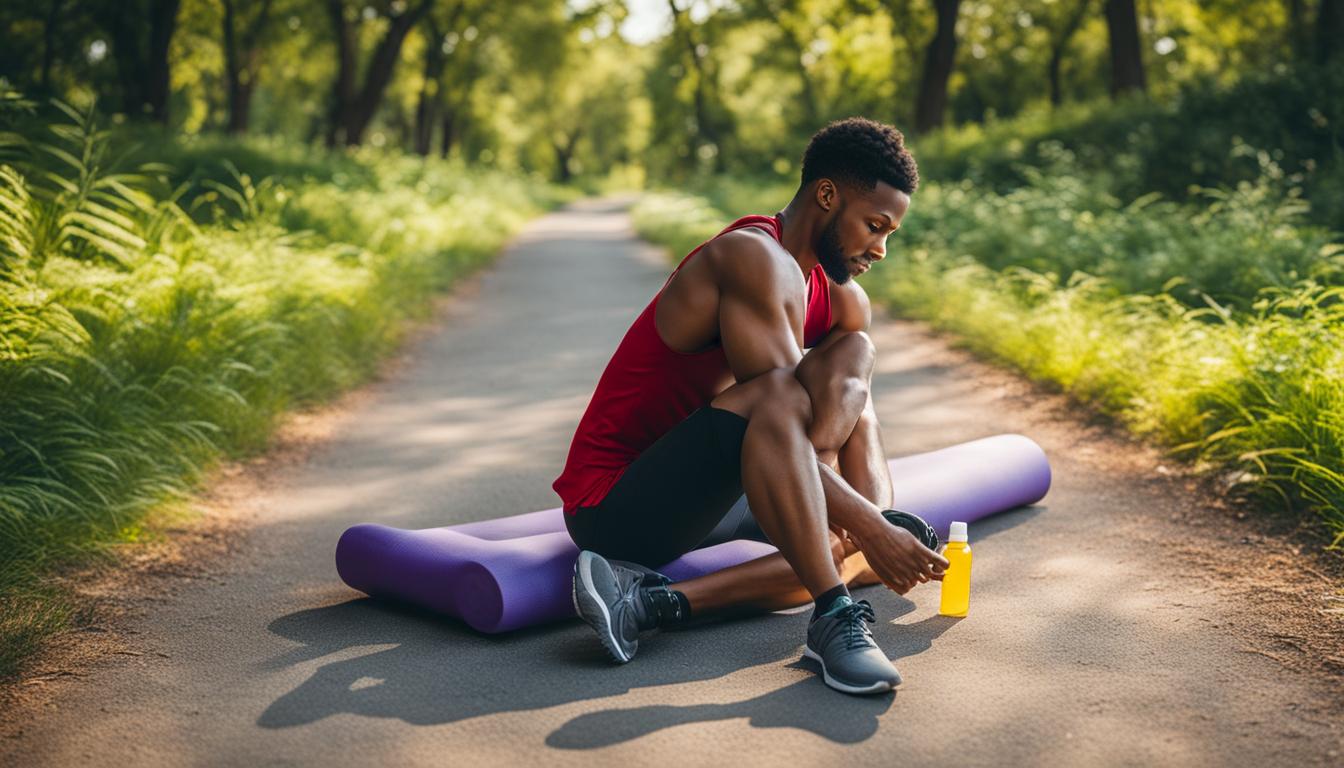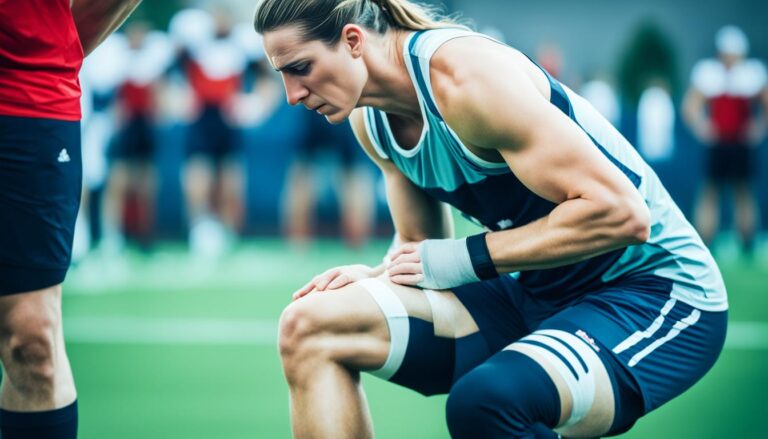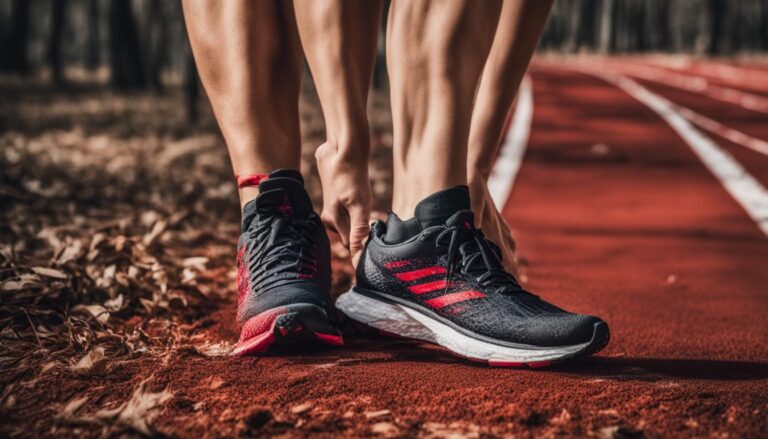Soothing Sore Knees from Running: Top Tips
Are you experiencing sore knees from running? If so, you’re not alone. Knee pain is a common issue among runners, often known as patellofemoral pain syndrome or runner’s knee. It can be frustrating and hinder your running performance. However, there are steps you can take to find relief and keep running pain-free.
One of the key factors in preventing and alleviating knee pain from running is addressing the underlying weakness in your core and hips. Strengthening these areas can help improve your stability and diminish the strain on your knees.
Key Takeaways:
- Runner’s knee, also known as patellofemoral pain syndrome, causes pain in the front of the knee.
- Weakness in the core and hips can contribute to runner’s knee.
- To prevent runner’s knee, stretch the muscles around the knees, strengthen the leg muscles and core, use cold therapy on sore knees, mix in other forms of cardio, and stay hydrated.
- Proper warm-up, stretching, and strengthening exercises are essential before running to prevent knee pain.
- Cold therapy can provide relief for sore knees after running.
Stretching and Strengthening for Sore Knees
Before hitting the pavement, it’s crucial to prepare your body with a light warm-up and targeted stretching routine. By focusing on stretching the quadriceps, hamstrings, and calves, you can help alleviate soreness and prevent knee pain from running. Consider incorporating these exercises into your pre-run routine:
- Quadricep Stretch: Stand upright and grab your right foot with your right hand, gently pulling it towards your glutes. Hold for 30 seconds and then repeat on the left side.
- Hamstring Stretch: Sit on the edge of a chair with your right foot extended in front of you. Lean forward, reaching towards your toes while keeping your back straight. Hold for 30 seconds and then switch to the left leg.
- Calf Stretch: Stand facing a wall with your hands against it at shoulder height. Step your right foot back, keeping both heels flat on the ground. Lean into the wall until you feel a stretch in your right calf. Hold for 30 seconds and then switch to the left leg.
To maximize the effectiveness of these stretches, consider contracting the opposite muscle group at the same time. For example, when stretching the quadriceps, engage your hamstrings by pulling your foot closer to your glutes.
In addition to stretching, strengthening the leg muscles, core, and glutes is vital for preventing knee pain from running. Incorporate the following exercises into your regular routine:
- Hamstring Curls: Lie face down on a mat with your legs straight. Bend your knees, bringing your heels towards your glutes. Slowly lower your legs back down and repeat for 10-15 reps.
- Wall Squats: Stand with your back against a wall, feet shoulder-width apart. Slide down into a squat position, with your knees at a 90-degree angle. Hold for 30 seconds to 1 minute and then push back up to the starting position. Repeat for 10-15 reps.
- Bridge Exercises: Lie on your back with your knees bent, feet flat on the ground. Lift your hips off the floor, engaging your glutes and core. Hold for 5 seconds and then lower your hips back down. Repeat for 10-15 reps.
For an added challenge, plyometric strength exercises and light weight training can also help improve knee stability and prevent future injuries.
“Stretching the muscles around the knees and strengthening the surrounding leg muscles are instrumental in preventing knee pain from running.”
Stretching and Strengthening Exercises for Sore Knees
| Exercise | Description |
|---|---|
| Quadricep Stretch | Stand upright and pull your foot towards your glutes, focusing on one leg at a time. |
| Hamstring Stretch | Sit on the edge of a chair and lean forward towards your toes, stretching one hamstring at a time. |
| Calf Stretch | Stand facing a wall, step one foot back, and lean into the wall to stretch your calf muscles. |
| Hamstring Curls | Lie face down and bend your knees, lifting your heels towards your glutes to engage the hamstrings. |
| Wall Squats | Stand with your back against a wall, slide down into a squat position, and hold before pushing back up. |
| Bridge Exercises | Lie on your back, lift your hips off the floor, engaging your glutes and core. |
Cold Therapy for Sore Knees
If you experience sore knees after running, cold therapy can provide much-needed relief. One effective method is to immerse your knees in frigid water for several minutes. This technique helps reduce inflammation and soothe the pain.
However, before attempting cold therapy, it is essential to consult with a doctor or healthcare professional. They can evaluate your specific condition and provide guidance on whether this method is appropriate for you.
In addition to cold therapy, using knee support during your runs can be highly beneficial. Knee support provides stability and helps alleviate pain and discomfort while running. Investing in high-quality knee support designed specifically for runners can make a significant difference in your comfort and overall running experience.
Remember, both cold therapy and knee support should supplement a comprehensive approach to managing and preventing knee pain. Incorporating stretching, strengthening exercises, and other preventive measures alongside these strategies will provide the best results for your knee health.
Why Use Knee Support?
Knee support plays a crucial role in protecting your knees during high-impact activities such as running. The constant pounding and repetitive movements can strain the knee joints and lead to discomfort or pain.
“Using knee support provides stability and helps distribute the forces exerted on the knee joint more evenly, reducing the risk of injury and promoting pain relief.”
Whether you are recovering from an injury or looking to prevent one, using knee support can offer valuable support and protection. It helps maintain proper alignment, absorbs shock, and provides compression to reduce swelling and inflammation.
Investing in well-fitting knee support that caters to the unique needs of runners can make a significant difference in your performance and overall knee health.
Mixing Up Your Cardio Routine
Prevent Knee Pain from Running
If you’re an avid runner, it’s important to diversify your cardio routine to prevent repetitive strain on your knees and reduce the risk of injury. Incorporating alternative forms of cardio can help ease the stress on your knees and give them a much-needed break from the repetitive motions of running.
Cycling is a great low-impact option that provides cardiovascular benefits without putting excessive strain on your knees. It allows for smooth, fluid movements that minimize impact and reduce the risk of knee pain. Additionally, cycling helps strengthen the leg muscles and improve overall endurance.
Another effective option is circuit training, which combines cardiovascular exercise with strength training. Circuit training typically involves a series of exercises done in quick succession, targeting different muscle groups throughout the body. By incorporating circuit training into your routine, you can maintain a high level of cardio while also building strength and stability in your legs, core, and upper body.
A well-rounded cardio routine not only helps prevent knee pain from running but also enhances your overall fitness and performance. By mixing up your workouts and incorporating cycling and circuit training, you can protect your knees from repetitive stress and maintain a healthy, active lifestyle.
| Benefits of Mixing Up Your Cardio Routine |
|---|
| Reduces the risk of knee pain and injury |
| Provides a break from the repetitive motions of running |
| Improves cardiovascular fitness |
| Strengthens leg muscles |
| Enhances overall endurance and performance |
By diversifying your cardio routine and incorporating activities that are low-impact and target different muscle groups, you can prevent knee pain from running and maintain a well-balanced fitness regimen. Remember to listen to your body, gradually increase the intensity and duration of your workouts, and seek professional guidance if you experience persistent knee pain or discomfort.
Hydration and Knee Health
Staying hydrated is essential for maintaining optimal muscle function and overall health. Proper hydration not only benefits your entire body but can also contribute to relieving knee pain while running. When it comes to running with knee pain relief, hydration plays a crucial role in supporting your knee health.
Before heading out for a run, it’s recommended to drink a tall glass of water. This not only helps quench your thirst but also prepares your body for the physical exertion ahead. Hydrating before your run ensures that your muscles are well-supplied with the fluids they need, reducing the risk of cramps and promoting optimal performance.
It’s equally important to replenish your fluids immediately after your run. This can be done by drinking another glass of water once you return home. Rehydrating post-run helps restore the fluids lost through sweat and keeps your body adequately hydrated. Adequate hydration also aids in the recovery process, promoting proper muscle repair and reducing inflammation.
The Importance of Hydration for Longer Runs
For longer runs or more intense workouts, hydrating the day before can provide additional support for your knees. By ensuring you are well-hydrated the day before, you’re setting yourself up for success, as hydrated muscles tend to perform better and are less prone to injury.
It’s important to note that certain beverages, such as alcohol, can have a dehydrating effect on the body. To promote knee health and running with knee pain relief, it’s best to avoid alcohol before and after your runs. Instead, opt for water and other hydrating options, such as electrolyte-rich sports drinks, to replenish your fluids and support your knee health.

Tips for Running Without Knee Pain
To prevent and relieve knee pain while running, there are several effective strategies you can incorporate into your routine. By following these tips, you can enjoy your runs without the nagging discomfort of knee pain.
1. Stretch before each run
Stretching is crucial before running to prepare your muscles and joints for the impact of the activity. Focus on stretching the quadriceps, hamstrings, and calves, as these muscle groups play key roles in supporting the knees. Stretching helps improve flexibility, reduces muscle tension, and minimizes the risk of strain or injury.
2. Strengthen the leg muscles
Strong leg muscles provide better support for the knees during running. Incorporate strength training exercises that target the quadriceps, hamstrings, and calves into your regular fitness routine. Additionally, don’t forget to work on your core and glutes, as a strong core helps maintain proper alignment and reduces strain on the knees.
3. Cross-train with low-impact exercises
Diversifying your exercise routine with low-impact exercises is beneficial for maintaining cardiovascular fitness while giving your knees a break from the repetitive impact of running. Consider activities such as swimming, cycling, or using an elliptical machine. These exercises provide cardiovascular benefits without putting excessive stress on your knees.
4. Gradually increase mileage
When striving to increase your running distance or intensity, it’s important to do so gradually. Increasing mileage too quickly can strain your muscles and joints, including your knees, leading to pain and potential injury. Instead, aim to increase your running volume by no more than 10% each week, allowing your body time to adapt and build strength.
5. Ice your knees after each run
After completing a run, applying ice to your knees can help alleviate any inflammation and reduce pain. Wrap an ice pack or a bag of frozen vegetables in a towel and apply it to your knees for 15-20 minutes. This ice therapy can help soothe soreness and promote faster recovery.
6. Consider anti-inflammatory medication and supplements
If knee pain persists despite your efforts, it may be helpful to consult with a healthcare professional about the use of anti-inflammatory medication. Nonsteroidal anti-inflammatory drugs (NSAIDs) can help reduce pain and inflammation. Additionally, certain dietary supplements, such as glucosamine and chondroitin, have shown potential benefits in managing joint health, but it’s important to consult with a healthcare professional before starting any new supplement regimen.
By implementing these tips, you can find relief from knee pain and continue running with reduced risk of injury. Always listen to your body, and if knee pain persists or worsens, seek medical attention for a proper diagnosis and individualized treatment plan.

| Tip | Description |
|---|---|
| Stretch before each run | Stretching prepares the muscles and joints, reducing the risk of strain or injury. |
| Strengthen the leg muscles | Strong leg muscles provide better support for the knees during running. |
| Cross-train with low-impact exercises | Diversify your routine with activities that reduce stress on the knees. |
| Gradually increase mileage | Progressively increase running distance or intensity to avoid straining the knees. |
| Ice your knees after each run | Apply ice to reduce inflammation and soothe knee soreness. |
| Consider anti-inflammatory medication and supplements | Consult a healthcare professional for options to manage pain and support joint health. |
Recovery and Return
If knee pain develops, it is important to rest and give the knees time to heal. Our bodies need proper recovery to prevent knee pain from running.
During this time, ICE therapy can effectively reduce inflammation and provide soothing relief. Elevating the affected leg can also help reduce swelling and promote healing. Additionally, using elastic bandages or knee wraps can offer support and stability to the knee joint.
Stretching and strengthening exercises, as recommended by a physical therapist, play a crucial role in the recovery process. These exercises help improve flexibility, restore muscle balance, and prevent future knee pain. Incorporating targeted stretches and exercises into your routine can prevent knee pain from running.
Listen to your body and avoid rushing back into intensive workouts. Returning to running should only be done when there is no pain in the knee, full range of motion is achieved, and the thigh muscles are strong and balanced.
| Recovery Tips for Preventing Knee Pain |
|---|
| Rest and give the knees time to heal |
| Apply ICE therapy to reduce inflammation |
| Elevate the affected leg to reduce swelling |
| Use elastic bandages or knee wraps for support and stability |
| Follow stretching and strengthening exercises recommended by a physical therapist |
| Gradually return to running only when pain-free and with full range of motion |
By following these recovery tips and taking the necessary time to heal, you can prevent future knee pain from running. It is essential to prioritize your body’s needs for a safe and sustainable running experience.
Conclusion
Runner’s knee, also known as patellofemoral pain syndrome, can be a frustrating and painful condition for runners. However, with the right techniques and strategies, relief from knee pain is possible. By incorporating proper stretching and strengthening exercises, you can help alleviate the strain on your knees and improve their overall stability.
Cold therapy can also provide temporary relief for sore knees. Whether it’s sitting in frigid water or using knee support during running, these methods can help reduce inflammation and discomfort. Additionally, diversifying your cardio routine by incorporating activities like cycling and circuit training can minimize the repetitive strain on your knees.
Staying hydrated is crucial for maintaining optimal muscle function and knee health. By drinking enough water and avoiding alcohol, you can support the overall well-being of your joints. Lastly, always listen to your body and prioritize rest and recovery when needed. If the pain persists or worsens, it’s important to seek medical attention for further evaluation and intervention.
By following these guidelines, you can find relief from running knee pain and continue pursuing your passion for running with a reduced risk of injury. Remember, taking care of your knees is essential for long-term running success. Stay proactive, stay consistent, and prioritize your knee health to keep running strong.
FAQ
How can I soothe sore knees from running?
To soothe sore knees from running, it is important to stretch the muscles around the knees, strengthen the leg muscles and core, use cold therapy on sore knees, give the knees a break by mixing in other forms of cardio, and stay hydrated.
What stretching and strengthening exercises can help with sore knees from running?
Stretching the quadriceps, hamstrings, and calves before running is important. Strengthening the leg muscles, including the hamstrings and quadriceps, as well as the core and glutes, is crucial for preventing knee pain. Plyometric strength exercises and light weight training can also be beneficial.
How can I use cold therapy to relieve knee pain from running?
If the knees are sore after running, cold therapy can provide relief. This can be done by sitting in frigid water for several minutes. However, it is important to consult with a doctor before attempting this method. Additionally, using knee support during running can help alleviate pain and provide stability.
How can I prevent knee pain from running?
To prevent knee pain from running, it is recommended to mix in other forms of cardio into your routine. Cycling and circuit training are alternative options that can help ease the stress on the knees. By diversifying your workouts, you can give your knees a break from the repetitive motions of running.
How does hydration affect knee health when running?
Staying hydrated is essential for maintaining optimal muscle function and overall health. It is recommended to drink a tall glass of water before running and immediately after returning home. For longer runs, hydrating the day before and avoiding alcohol can help support knee health.
What are some tips for running without knee pain?
To prevent and relieve knee pain while running, it is important to take several steps. These include stretching before each run, strengthening the leg muscles, cross-training with low-impact exercises, gradually increasing mileage, and icing the knees after each run. It may also be helpful to consider using anti-inflammatory medication and certain dietary supplements, such as glucosamine and chondroitin, under medical guidance.
How can I recover and safely return to running after knee pain?
If knee pain develops, it is important to rest and give the knees time to heal. ICE therapy, elevation, and the use of elastic bandages or knee wraps can offer support and reduce inflammation. Stretching and strengthening exercises, as recommended by a physical therapist, can aid in the recovery process. It is crucial to listen to your body and not rush back into intensive workouts. Returning to running should only be done when there is no pain in the knee, full range of motion is achieved, and the thigh muscles are strong and balanced.
How can I find relief from running knee pain?
Runner’s knee, or patellofemoral pain syndrome, is a common injury among runners that causes pain in the front of the knee. By following proper stretching and strengthening techniques, using cold therapy, diversifying cardio routines, staying hydrated, and taking necessary rest and recovery, individuals can find relief from knee pain and continue running with reduced risk of injury. It is essential to listen to the body and seek medical attention if necessary for severe cases that require further intervention.







